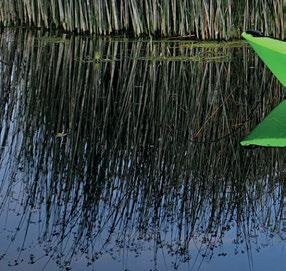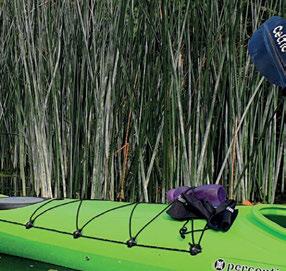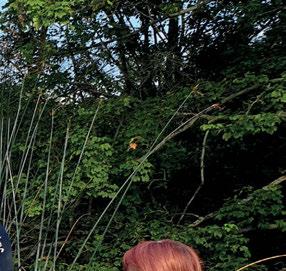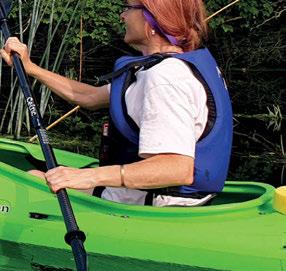
6 minute read
Love Your Waterways

canals by kayak





Waterways talks paddling the inland waterways and beyond with WRG volunteer Helen Dobbie




River Stour at Dedham.
I've been kayaking on inland and coastal waters for about
five years. A stint in the Territorial Army many years ago fi rst introduced me to kayaking, but it was only once I’d been invited to a local canoe club by a iend more recently that I took up the sport as a hobby. I’d say I get out on the water a couple of times a month – as with anything like this, it’s not as much as I’d like. You have to have a balance between work, other hobbies and family responsibilities.
A club is a great way to learn because you can hire craft and go out as part of a group.
We meet once a week and go along the River Colne in Colchester. Initially, I’d pay to use one of the club boats for each session but then decided to get my own. I’ve now got two kayaks; I started with a hybrid one that’s suitable for inland waterways and some white waters, and then got another one that’s designed as a seagoing cra . The hybrid one lives on top of my narrowboat which is based on the River Stort.
The inland waterways are definitely safer
than the coast. I don’t particularly understand tides or wind but I go with people who do. I’m more comfortable on non-tidal waters but canals do still come with their challenges – there can be a lot of portages because of all the locks. My partner Mark, who lives on the coast, is happier with kayaking on the sea, so we do both. If you’re going to paddle on the coast, you really need to be prepared and it’s always recommended that you’re with a small group. There’s lots of useful technology available these days – you can look online and get up to date information.
You need to make sure that, as a minimum,
you've got a phone (or a Personal Locator Beacon when going to sea) as well as your kayak, paddle and buoyancy aid – that’s your starter kit. I’ve also got a helmet and a spray deck, although I don’t tend to use those while inland; it’s only if you’re going over weirs or in white water that you particularly need them. I did have a wetsuit but now I’ve got some rubber trousers, a decent waterproof kayaking jacket and gloves (or something called ‘pogies’ that fi t over the paddles and you put your hands in). It’s not just about having a kayak, it’s also making sure, as with any hobby, that you’re prepared. You need the right kit, especially if you’re going to go out when it’s wet and windy. I do canal restoration work and I wouldn’t go on site without my steeltoe-capped boots, high-vis vest, safe glasses and a hard hat.

Volunteering with the Waterway Recovery Group.

I belong to British Canoeing, which regularly holds paddle
challenges. The one last summer was either 60 or 120 miles, and I completed the shorter distance. For the smaller winter challenge, which was in January and February this year, my partner and I did four 8-mile paddles. We kayaked to Bishop’s Stortford where there’s a nice little coffee shop that I went into while wearing my rubber trousers! We also did a coastal one when there wasn’t any wind – it was misty and really quite beautiful. I’d recommend finding a good tea room on your route or taking a flask of coffee with you if you’re paddling in the winter.

My narrowboat is based on the Stort, so I've done a lot of paddling on the river around
there. I’ve walked the length of the Chelmer & Blackwater Navigation but I haven’t paddled it yet – we need to work out the logistics because it requires one car with roof bars for the kayaks and then another car to shuttle to the other end. Going with a canoe club makes it a bit easier because you can arrange transport with a few more people. Last summer I did quite a lot on the Grand Union Canal, River Lea and the Olympic Park, which has some interesting portages, so it’s probably not for the inexperienced kayaker. We also went down to Cornwall and hired a couple of kayaks for the day, which was nice.

The most adventurous paddle I've done is the Thames
Tideway. I’d previously experienced it on trip-boats and in a narrowboat from Limehouse to Brentford. The Thames Clippers are scary when you’re in a narrowboat; the guy leading the group had a VHF radio and was in contact with all the big boats – certainly when we were going through the bit near Tower Bridge which is quite busy with trip-boats, rubbish barges and private vessels. With the canoe club, we went from Battersea to Greenwich, which was incredible. When you’re in a kayak, it gives you a different view of the river to when you’re walking the
With the swans on the Stour. Mark on the River Stour.

River Lea in London.
path or on a narrowboat. It’s definitely a journey you have to paddle as part of a group – not one for just setting off on your own to do.
There are still quite a few places on my
bucket list. I want to do the Caledonian Canal in Scotland and I’m not likely to get my narrowboat up there so it would be perfect for kayaking. We’ve looked into doing it as a camping trip as there are places that you can overnight along the canal and we reckon it would take around four or five days.
I love being outdoors, appreciating the
countryside and enjoying the wildlife. Recently,
when it was too windy to go out on the coast, we headed onto the River Stour again. Going round some of the corners, we kept getting blown across the water so we’d have to go backwards, come at it from a different angle and paddle like mad. So sometimes you go back home and you’re absolutely knackered.
I've been volunteering with the Waterway Recovery Group since before I bought the
narrowboat in 1991 and have been an assistant leader on a few week-long canal camps on the Chelmer. I do it for similar reasons to the kayaking – being outdoors, contributing to the waterways, and always having an amazing mix of people to share the experience with.
What does Love Your Waterways mean to me?
I think being on the water and outdoors grounds people, helps them to slow down a bit and connect to nature. I particularly like watching all the water birds – they’re very territorial at this time of year. I would say to anyone who is thinking of kayaking: get out and try it. Do it as part of a club and make sure that you’ve got the necessary safety gear. Just give it go!










